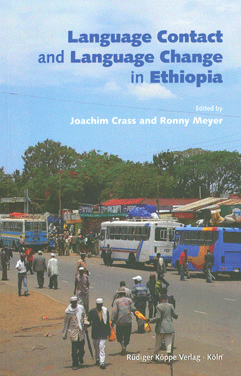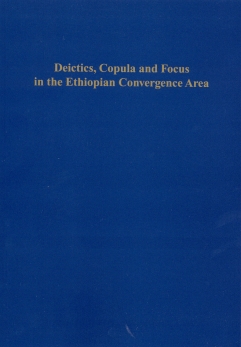



The database on Ethiopian languages increased considerably due to the activities within the Collaborative Research Center 295 Cultural and Linguistics Contacts: Processes of Change of North Eastern Africa and West Asia at the Johannes Gutenberg University, Mainz/Germany. The research within this center was twofold. First, basic research led to the publication of descriptive grammars of different Ethiopian languages, second, the results were applied to update the status of the Ethiopian Linguistic Area and to extend its features. Two workshops in 2004 and 2007, organized by Joachim Crass and Ronny Meyer which provided an international platform for the assessment of the Ethiopian Linguistic Area.
The workshop in 2004 dealt with deictics, copula and focus in several Cushitic, Omotic and Semitic languages (cf. Crass and Meyer, Deictics, Copula and Focus in the Ethiopian Convergence Area, 2007, see link below). The second workshop, held on December 13–14, 2007, discussed linguistic contact and contact-induced language change in Ethiopia from a broader perspective. The six contributions in the present volume, which developed out of the second workshop, represent the diversity of current research on linguistic contacts and on language change in Ethiopia. The present volume offers examples confirming the assumption that Ethiopian languages regardless of their genetic affiliation deliberately display areal patterns by sharing a number of conceptual and structural similarities. It offers a potential enhancement for the discussion on language-internal versus contact-induced linguistic change in the Ethiopian Linguistic Area.
CONTENTS
Joachim Crass / Ronny Meyer: Introduction
Binyam Sisay Mendisu: Copula and/or focus – The morpheme -(k)ko in two East Ometo languages
Ronny Meyer: The quotative verb in Ethiosemitic languages and in Oromo
Ongaye Oda: The spread of punctual derivation in Dullay and Oromoid languages
Christian J. Rapold / Silvia Zaugg-Coretti: Exploring the periphery of the Central Ethiopian Linguistic Area – Data from Yemsa and Benchnon
Sascha Völlmin: Some dialectal differences between Gumer and Chaha (Gurage)
Silvia Zaugg-Coretti: The morpheme -tu as a focus marker in Yemsa (Omotic) and Oromo (Cushitic)
Review by Yvonne Treis in Afrikanistik-Ägyptologie online 2011
Under these links you will find further descriptions of Ethiopian / Ethio-semitic languages and cultures and publications by the volume editors:
The publication [...] collects articles which present some very interesting and new data as well as interpretations on Ethiopian languages, giving them a chance to see the daylight, and, what is more, proposing some theoretical frame, namely the contact-change phenomenon. In the case of Ethiopian languages, this kind of approach is both justified and desirable. In descriptions of Ethiopian languages difficulties arise mainly on the level of the origin of linguistic features, and therefore an analysis of any Ethiopian language, including Amharic and Oromo as the biggest ones, cannot be complete without the contact approach. The most recent publication by Crass and Meyer proves this in an excellent, unaffected way, and I am sure its follow-up will reach me soon.
Laura Lykowska in Studies in the Department of African Languages and Cultures, 44/2010, 126-129
We need more contributions like the ones presented here, i.e. tests of the features proposed for the Ethiopian Language Area (Rapold & Zaugg-Coretti’s contribution), new assessments of data collected and hypotheses brought forward at the time when Ethiopian languages were first investigated (Binyam Sisay’s and Ongaye Oda’s contributions), as well as fine-grained and empirically well-grounded studies of individual grammatical phenomena (Meyer’s, Völlmin’s and Zaugg-Coretti’s contributions).
Yvonne Treis in Afrikanistik online, www.afrikanistik-online.de/archiv/2011/2848, 1-7
[...] the volume is a collection of quite interesting contributions on a wide palette of languages spoken in the Horn of Africa. It is an important reading for scholars interested in Cushitic, Ethio-Semitic, and Omotic, as well as in contact phenomena and areal linguistics.
Giorgio Banti in Aethiopica, 17/2014, 227-236
© 2026 by Rüdiger Köppe Verlag – www.koeppe.de